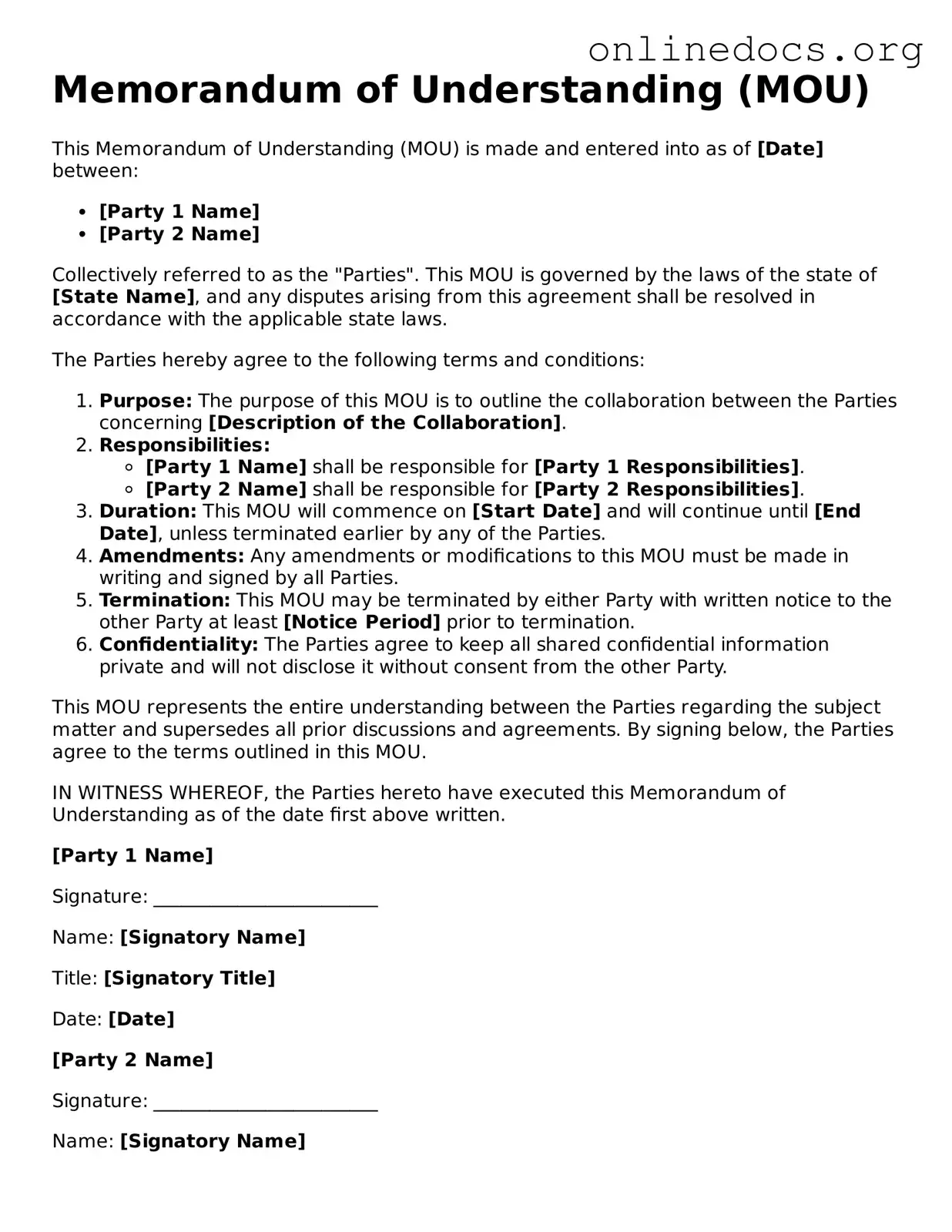A Letter of Intent (LOI) serves a similar purpose to a Memorandum of Understanding (MOU) in that it outlines the intentions of parties to enter into a formal agreement. While an LOI may express a preliminary commitment, it often includes key terms and conditions that the parties agree to negotiate further. Unlike an MOU, which may be non-binding, an LOI can contain binding provisions, such as confidentiality clauses or exclusivity agreements. Both documents aim to clarify the expectations of the parties involved, but the LOI often has a more formal tone and structure.
An Agreement in Principle (AIP) is another document that resembles an MOU. It signifies that the parties have reached a preliminary understanding on key points but have yet to finalize a formal contract. An AIP often serves as a stepping stone toward a more comprehensive agreement. While an MOU may list mutual goals and intentions, an AIP typically focuses on specific terms that the parties agree upon, laying the groundwork for future negotiations.
A Term Sheet is a concise document that outlines the main terms and conditions of a proposed agreement. Similar to an MOU, it is often used in negotiations to ensure all parties are aligned before drafting a full contract. Term sheets are commonly used in finance and investment contexts, detailing elements such as pricing, timelines, and responsibilities. While an MOU may cover broader intentions, a term sheet is usually more focused on specific deal points.
A Partnership Agreement is a formal document that establishes the terms of a business partnership. While an MOU may outline the intent to collaborate, a partnership agreement specifies the roles, responsibilities, and profit-sharing arrangements of each partner. This document is legally binding and provides a detailed framework for the partnership, whereas an MOU may serve as a preliminary understanding without the same level of specificity.
A Non-Disclosure Agreement (NDA) shares similarities with an MOU in that both documents aim to protect sensitive information during negotiations. An NDA is legally binding and explicitly prohibits the sharing of confidential information between parties. While an MOU may touch on confidentiality, an NDA provides a more rigorous legal framework to safeguard proprietary information, particularly in business dealings.
A Service Level Agreement (SLA) is a contract that defines the expected level of service between a service provider and a client. Similar to an MOU, an SLA outlines mutual expectations and responsibilities. However, an SLA is more detailed, often specifying performance metrics, response times, and penalties for non-compliance. While an MOU may express intent to collaborate, an SLA establishes concrete standards for service delivery.
A Collaboration Agreement formalizes the terms under which two or more parties will work together on a specific project or initiative. Like an MOU, it clarifies the roles and responsibilities of each party. However, a collaboration agreement typically includes more detailed provisions regarding resource allocation, timelines, and deliverables. This document is often binding and serves as a comprehensive guide for the collaborative effort.
A Joint Venture Agreement outlines the terms and conditions under which two or more parties will collaborate on a specific business project. Similar to an MOU, it establishes mutual goals and responsibilities. However, a joint venture agreement is more formal and legally binding, often detailing profit-sharing arrangements, governance structures, and exit strategies. While an MOU may signify intent, a joint venture agreement solidifies the partnership into a legal entity.
The Vehicle Release of Liability form is an important document that helps clarify the responsibilities associated with vehicle ownership transitions. This form not only protects the seller by officially notifying the state that they are no longer liable for the vehicle, but it also serves the buyer by documenting the change of ownership. For those looking to navigate this process smoothly, resources like UsaLawDocs.com can provide essential guidance and templates to facilitate the transaction.
A Franchise Agreement is a legal document that governs the relationship between a franchisor and a franchisee. While an MOU may express interest in entering into a franchise arrangement, a franchise agreement contains detailed terms, including fees, operational guidelines, and brand standards. This document is binding and provides a comprehensive framework for the franchise relationship, whereas an MOU serves as an initial expression of interest.
A Purchase Agreement details the terms of a sale between a buyer and a seller. Similar to an MOU, it outlines the intentions of both parties regarding the transaction. However, a purchase agreement is legally binding and specifies critical elements such as price, payment terms, and delivery conditions. While an MOU may indicate a desire to proceed with a sale, a purchase agreement formalizes the transaction and provides legal protections for both parties.
